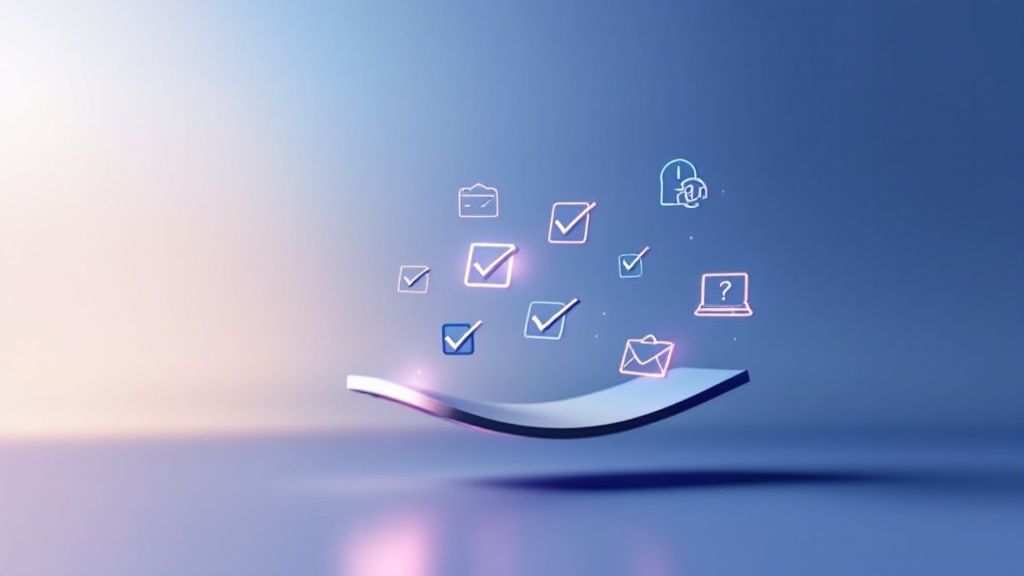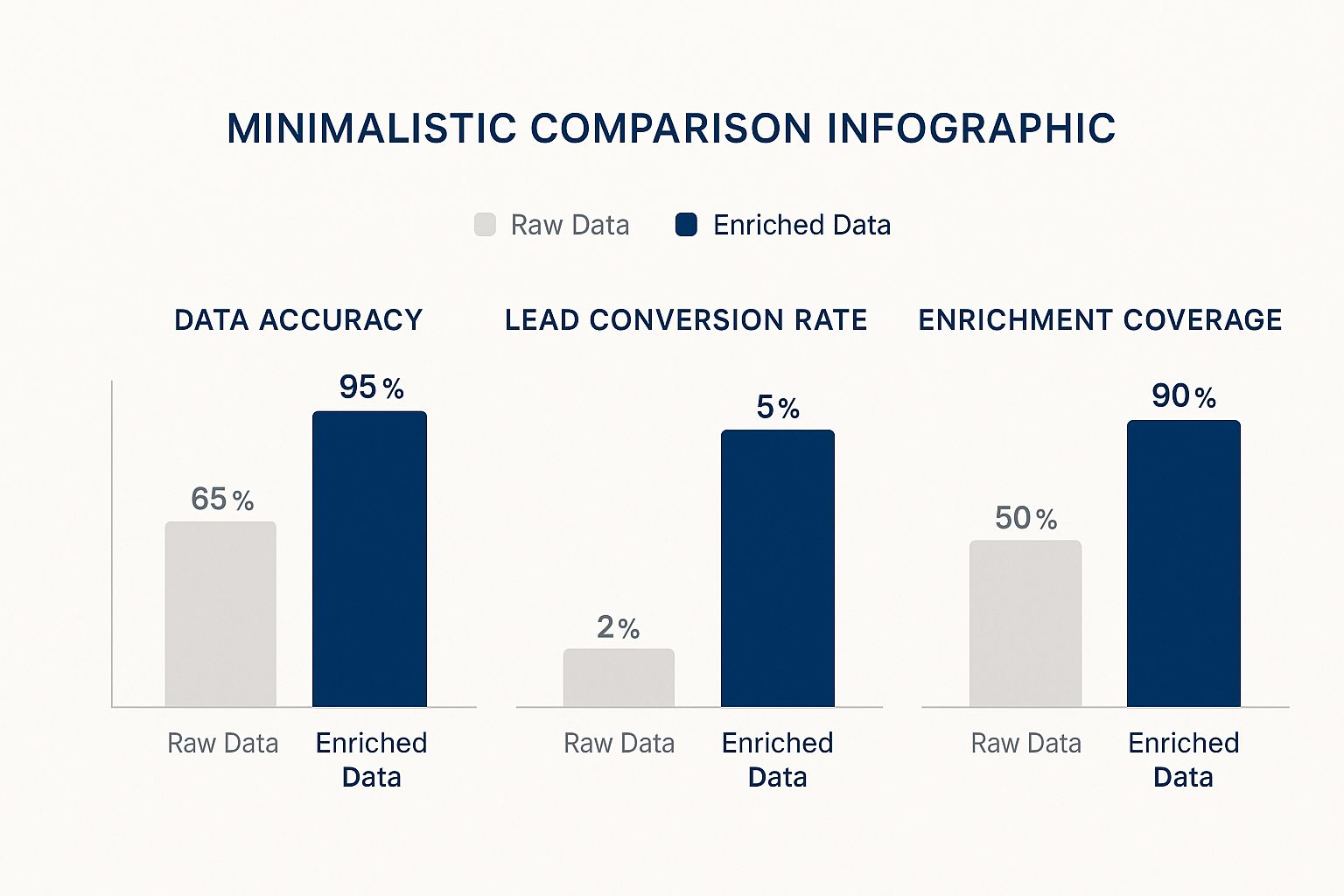Signal Based Selling: The Modern Sales Playbook
Discover how signal based selling transforms revenue teams. Learn to use buyer intent data and AI to focus sales efforts and close deals faster.
Learn how B2B data enrichment transforms raw contacts into valuable insights. Discover strategies and tools to enhance your sales and marketing efforts.
TL;DR: B2B data enrichment turns your incomplete contact lists into powerful strategic assets. By adding crucial details like company size, tech stack, and buying intent, you empower your sales and marketing teams to personalize outreach, score leads accurately, and close deals faster. It's the fastest way to stop guessing and start making data-driven decisions that fuel growth.
Think of B2B data enrichment as the process of taking your existing customer data—often patchy and incomplete—and fleshing it out with crucial details from other reliable sources. It’s how you turn a simple list of contacts into a deep, actionable set of profiles for your sales and marketing teams.
Essentially, you're transforming incomplete contact records into something much more powerful, giving your team the insights needed to personalize their outreach and, ultimately, close deals faster.

In practice, B2B data enrichment turns a basic contact list from a simple directory into a real strategic asset. Instead of working with just a name and an old email address, your CRM can be packed with genuinely useful details about your prospects and customers.
This is usually an automated process that layers crucial information onto your existing records. The end goal? Making sure your teams are always working with accurate, relevant, and complete data.
With enriched data, your teams can finally:
At the end of the day, it's all about making smarter, data-driven decisions that genuinely fuel your company's growth.
At its core, B2B data enrichment is all about taking the raw, often incomplete data you have on your prospects and customers and making it dramatically more valuable. It’s the process of merging your internal data—the stuff sitting in your CRM right now—with validated, up-to-date information from external sources. The result? Complete, accurate, and truly actionable profiles.
Think about it this way: your CRM has a lead with just a name and an email. That's a starting point, but it's not much to go on. Enrichment adds the critical context you need—like their job title, company size, industry, the tech their company uses, and even recent buying signals. This isn't just about cleaning up data; it's about layering on intelligence.
It’s easy to confuse data enrichment with data cleaning, but they play two very different roles. Data cleaning is about fixing what’s already there. It’s basic database hygiene—correcting typos, zapping duplicates, and standardizing formats.
Enrichment, on the other hand, is about adding new, strategic information that was never there in the first place.
This distinction is crucial. Cleaning keeps your database tidy, but enrichment is what lets your team move from basic accuracy to real strategic insight. With some businesses losing millions each year to bad data, both are essential. But only enrichment unlocks new paths to growth.
The whole point of B2B data enrichment is to give your revenue teams a complete, 360-degree view of every single prospect and customer. This deep insight is the bedrock of any high-performing sales and marketing engine. It fundamentally changes how you qualify leads, personalize outreach, and make big-picture decisions.
Enrichment turns scattered data points into cohesive intelligence. It helps your teams understand not just who their customers are, but what they need and when they need it. This shift is non-negotiable in modern B2B sales.
When your teams have the full picture, they can suddenly do things that were impossible before:
Ultimately, B2B data enrichment provides the "why" behind your outreach. It gives you the context needed to engage prospects with relevant, timely communication—laying the groundwork for stronger relationships and, of course, faster revenue growth.
Effective B2B data enrichment is all about layering different kinds of information onto the contacts you already have. You have to understand these data categories to get a real, multi-dimensional view of your prospects and customers. Each one gives you unique insights that lead to sharper targeting and better personalization.
Think of these categories as different lenses you can use to look at an account. When you combine them, you finally see the complete picture—turning a simple contact record into a strategic profile.
Firmographics are the basic facts that describe a company, a lot like how demographics describe a person. This is the "who" and "what" of a business, giving you the essential context to see if they're even a potential fit. Without solid firmographic data, you’re just guessing if a lead matches your Ideal Customer Profile (ICP).
Common firmographic data points include:
While firmographics zoom in on the company, demographics drill down to the specific people working there. This data is absolutely essential for finding the right decision-makers and influencers within a target account. It helps you answer the critical question, "Who do I actually need to talk to?"
This category includes details like:
When you combine firmographics and demographics, you stop targeting "manufacturing companies" and start targeting "VPs of Operations at manufacturing companies in the Midwest with over 500 employees." The jump in precision is huge.
Technographics tell you exactly what technologies a company uses. For B2B sales and marketing teams, this information is a goldmine. It gives you direct insight into a company's existing tech stack, potential integration opportunities, and even where their current vendors are vulnerable. For any SaaS company, this data is especially powerful.
Key technographic insights include:
Intent data is the most dynamic category of all. It captures behavioral signals that show a company is actively researching solutions just like yours. This is what helps you prioritize the accounts that are in-market and ready to buy right now. It shifts your strategy from being just descriptive to truly predictive. You can learn more about how to use comprehensive account data to get a competitive edge.
Intent signals often include:
Now, let's pull all these categories together to see how they fit into a broader strategy. Each data type offers a unique piece of the puzzle, and understanding their specific business use is key to unlocking their full value.
| Data Category | Example Data Points | Primary Business Use |
|---|---|---|
| Firmographic | Industry, company size, annual revenue, location | Foundational segmentation and defining your Ideal Customer Profile (ICP). |
| Demographic | Job title, seniority level, department, function | Identifying key decision-makers and tailoring outreach to the right people. |
| Technographic | CRM, marketing automation, cloud provider, ERP system | Uncovering integration opportunities, competitive takeaways, and technical needs. |
| Intent | Keyword searches, content downloads, competitor research | Prioritizing in-market accounts and timing outreach for maximum impact. |
As the table shows, it's the combination of these data types that moves you from basic lead generation to strategic account intelligence. By layering firmographic, demographic, technographic, and intent data, you build a rich, actionable profile that guides every sales and marketing decision.

Let's move beyond theory and talk about what a solid B2B data enrichment strategy actually delivers. Clean, accurate data isn't some "nice-to-have" administrative asset—it's the fuel that powers high-performing sales and marketing engines. When your teams genuinely trust the information in your CRM, their entire approach shifts. Guesswork disappears, replaced by proactive, strategic engagement.
This transformation really kicks off with efficiency. Imagine your reps spending less time digging around for a prospect's company size, tech stack, or recent funding and more time doing what they do best: selling. This boost in productivity is one of the most immediate and impactful returns you'll see.
The impact here isn't small. Companies that get serious about data enrichment report significant, measurable improvements. For instance, many see a 25% increase in sales productivity and a 15% jump in marketing ROI.
Beyond that, a staggering 80% of businesses using contact enrichment report a healthier sales pipeline, often leading to a 20% increase in revenue. This isn't just about working harder; it's about working smarter, and that efficiency gain translates directly into more effective outreach and shorter sales cycles.
Good data completely changes how you qualify and prioritize leads. Once you have enriched firmographic and technographic details, your lead scoring models suddenly become far more precise. You can automatically flag high-value accounts that perfectly match your Ideal Customer Profile (ICP), making sure your sales team invests its time where it will count the most.
This precision flows right into your marketing efforts. In fact, a robust B2B data enrichment process is a non-negotiable first step if you want to develop a comprehensive content marketing strategy that actually resonates with your target audience.
Enriched data is what lets you move from a generic "Dear [First Name]" email to hyper-relevant messaging that references a prospect's industry, their specific challenges, or even recent company news. That level of personalization isn't just a bonus anymore; it's what buyers expect.
Ultimately, enriched data gives you a clearer, more actionable view of your entire market. It hands your teams the intelligence they need to make better decisions at every single stage of the customer journey.
Here are a few of the key benefits you'll start to see:

Picking the right approach for B2B data enrichment isn’t a one-size-fits-all decision. The best strategy really hinges on your company’s scale, budget, and the technical skills you have in-house. Each method strikes a different balance between cost, speed, and accuracy, so it's critical to align your choice with your strategic goals.
Broadly speaking, you have three paths you can take: good old-fashioned manual enrichment, building an automated system yourself, or partnering with a third-party tool. Each route comes with its own set of pros and cons that you need to get your head around before committing time and money.
Making the right choice early on saves you from costly rework down the line and ensures your sales and marketing teams get the quality data they actually need to hit their numbers.
The most straightforward approach is just doing it by hand. This usually means your SDRs, BDRs, or data analysts are the ones manually digging for information online and plugging it into your CRM.
This method gives you a ton of control and can work well for very small-scale operations. It’s also useful if you’re only enriching a handful of high-value accounts with super-specific, niche data points.
But let's be honest, this strategy is a nightmare to scale. It’s incredibly labor-intensive, prone to human error, and—most importantly—it pulls your sales reps away from their primary job of selling. While the direct software cost is zero, the hidden cost in salaries and lost productivity can be huge. For most growing businesses, manual enrichment quickly becomes a major bottleneck.
If you have a sizable engineering team, building a custom, in-house enrichment system can seem like a great idea. This path involves creating your own scripts and APIs to scrape public data sources and hook into various data providers. The biggest advantage here is having complete control and customization over your data processes.
The flip side? It requires a massive investment, not just in the initial build but in ongoing maintenance. Data sources change, APIs break, and compliance standards like GDPR are always evolving. This means your engineering team will be dedicating continuous effort just to keep the lights on.
This approach is typically reserved for large enterprises with very specific data needs that off-the-shelf tools just can’t meet.
For the vast majority of B2B companies, using a dedicated third-party tool offers the most balanced and practical solution. These platforms give you immediate access to massive, verified datasets and handle all the messy work of data sourcing, validation, and integration for you.
They connect directly to your CRM, offering real-time or batch enrichment with minimal setup. This approach is highly scalable, cost-effective, and ensures your team is working with compliant, up-to-date information.
While it comes with a subscription cost, the ROI from a boost in sales productivity and marketing effectiveness is usually pretty clear. For instance, a sophisticated sales intelligence platform can automate this entire process, freeing up your team to focus on what they do best: generating revenue. To dig deeper into how precise data can transform sales performance, you might find some great insights in this guide on unlocking growth with sales and analytics.
To help you visualize the trade-offs, here’s a quick breakdown of how the three main strategies stack up against key business criteria.
| Criteria | Manual Enrichment | In-House Automated | Third-Party Tool |
|---|---|---|---|
| Initial Cost | Low (no software) | Very High (dev resources) | Medium (subscription fees) |
| Ongoing Cost | High (salaries, lost productivity) | High (maintenance, updates) | Low to Medium (predictable fees) |
| Scalability | Very Low | High (if built well) | Very High |
| Speed & Efficiency | Slow and labor-intensive | Fast (once operational) | Fast and immediate |
| Accuracy | Variable (prone to human error) | High (if maintained) | High (vendor-verified) |
| Control | High | Total Control | Medium (vendor-dependent) |
| Time to Value | Immediate (but limited) | Very Slow (months to years) | Immediate (days to weeks) |
As you can see, the choice isn’t just about the initial price tag. It's about balancing short-term needs with long-term growth, and making sure your sales team has the fuel it needs without creating an operational burden. For most teams, a third-party tool simply provides the fastest, most reliable path to better data.
The world of B2B data enrichment is shifting under our feet, and artificial intelligence is the tectonic plate moving everything. Let's be honest, the old ways of updating data—manual uploads, quarterly cleanups—are just too slow for the pace of modern business. AI-powered enrichment doesn't just speed things up; it automates the whole process, going way beyond simple data appends to deliver insights that can actually predict what's coming next.
This new approach is a direct assault on the age-old problem of data decay. With an estimated 25–30% of B2B data going stale every single year, trying to keep up manually is a losing battle. AI flips the script by constantly monitoring data sources and updating your records the moment a change happens. This ensures your CRM reflects today's reality, not last quarter's news.
The real game-changer here is the move from reactive to predictive enrichment. AI doesn’t just tell you a prospect’s current job title; it analyzes signals across the web to forecast their next move. This is the magic of intent-based enrichment.
By tracking a prospect's digital footprint—things like their keyword searches, the whitepapers they download, or the webinars they attend—AI can pinpoint accounts that are actively in the market for a solution just like yours. This lets your team jump in at the perfect moment, often before a prospect has even reached out to one of your competitors.
This infographic paints a pretty clear picture of the impact. Moving from raw, static data to AI-enriched, dynamic data can have a massive effect on the sales metrics that matter most.

As you can see, good data does more than just clean up your database. It more than doubles lead conversion rates and dramatically boosts both accuracy and coverage, turning your CRM into a high-performance asset.
The future isn't about one-and-done data cleaning projects. It's about building a loop of continuous intelligence. AI-driven platforms are always on, constantly monitoring a huge range of signals—from press releases and SEC filings to job postings and social media activity—to give you a living, breathing profile of every single target account.
The goal is to transform your CRM from a static address book into a dynamic intelligence engine. AI makes this happen by not only updating your data but also interpreting it, giving your sales team the critical "why now?" behind their outreach.
This constant monitoring allows for a much smarter, more strategic approach to sales. Instead of blasting out generic messages, reps can use real-time insights to get personal and speak directly to a prospect’s immediate needs and priorities. For a closer look at how this works in practice, check out our guide on the AI prospecting tools that are leading this charge.
By automating the grunt work of research and insight generation, these systems free up sales teams to do what they do best: build relationships and close deals, all while armed with the most current and relevant information possible. The modern data strategy isn't about just having data anymore; it's about having intelligent, actionable insights delivered exactly when you need them.
Getting the most out of B2B data enrichment takes more than just a good tool—it requires a clear, deliberate plan. If you want to see a real return on your investment and sidestep the usual roadblocks, you need to follow a few established best practices from the jump.
This is about moving beyond just hoarding data and instead focusing on how that information will actively fuel your sales and marketing goals. A structured approach is what turns data enrichment from a simple IT project into a core piece of your revenue engine.
Before you touch a single record, you have to ask: what are we actually trying to accomplish here? Without clear goals, you’ll end up collecting a ton of irrelevant data that just creates noise instead of clarity. Your objectives should guide every single decision you make, from which data points matter most to how you'll measure success down the line.
The trick is to tie your enrichment efforts directly to specific business outcomes.
It’s tempting to grab every data point you can get your hands on, but that’s a fast track to bloated CRM records and confused sales reps. The real key is to focus on the fields that have the biggest impact on your sales and marketing motions. An over-enriched record packed with useless information is no better than an incomplete one.
Think about the absolute minimum your team needs to qualify a lead or personalize an email. For some, that might be just company size and industry. For others, it could be the specific marketing automation tool a company uses. Start small, prove the value, and then expand.
The goal isn't to have the most data; it's to have the right data. A lean, accurate, and highly relevant dataset will always outperform a massive, noisy one.
Your data enrichment tool should slide right into your existing workflow, not blow it up. Make sure it integrates cleanly with your CRM and marketing automation platforms to deliver real-time updates right where your teams live. This is crucial for preventing data silos and making sure the enriched information is immediately actionable.
Finally, remember that data enrichment is not a one-and-done project. Data goes stale. People change jobs, companies get acquired, and priorities shift. You absolutely need a process for continuous data maintenance to keep your information fresh and reliable. Regular audits and automated refreshes are your best defense against data decay, ensuring your team can always trust the information in front of them. For more on this, check out our list of free account research tools that can complement your strategy.
The biggest benefit is empowering your sales and marketing teams to work smarter, not harder. By adding critical context to your contact records, you improve lead scoring, enable deep personalization, and boost overall productivity. This leads directly to higher conversion rates and faster revenue growth.
Data cleaning focuses on fixing errors in the data you already have, like correcting typos or removing duplicates. Data enrichment is about adding new, valuable information that was missing, such as a company's annual revenue, the technologies they use, or recent buying signals. Both are important, but enrichment adds strategic depth.
Ideally, enrichment should be a continuous, real-time process. B2B data decays quickly (around 30% per year) as people change jobs and companies evolve. If real-time isn't possible, you should aim to refresh your entire database at least once per quarter to maintain its accuracy and effectiveness.
Yes, as long as you partner with a reputable provider that sources data ethically and transparently. Compliant vendors adhere to regulations like GDPR and CCPA. It's your responsibility to verify your vendor's compliance and ensure your own data handling processes meet legal standards.
Ready to stop wasting time on manual research and start acting on real-time account intelligence? Salesmotion automatically uncovers critical signals and generates tailored insights, so your team can focus on what matters most—closing deals. See how you can save 8+ hours per rep weekly and boost your pipeline at https://salesmotion.io.
Discover how signal based selling transforms revenue teams. Learn to use buyer intent data and AI to focus sales efforts and close deals faster.
Discover what is a buying signal in sales with our guide. Learn to spot verbal and digital cues to qualify leads and close deals faster.
Explore zoominfo alternatives (including salesmotion) and compare top options, features, and pricing to pick the best fit for your sales team.